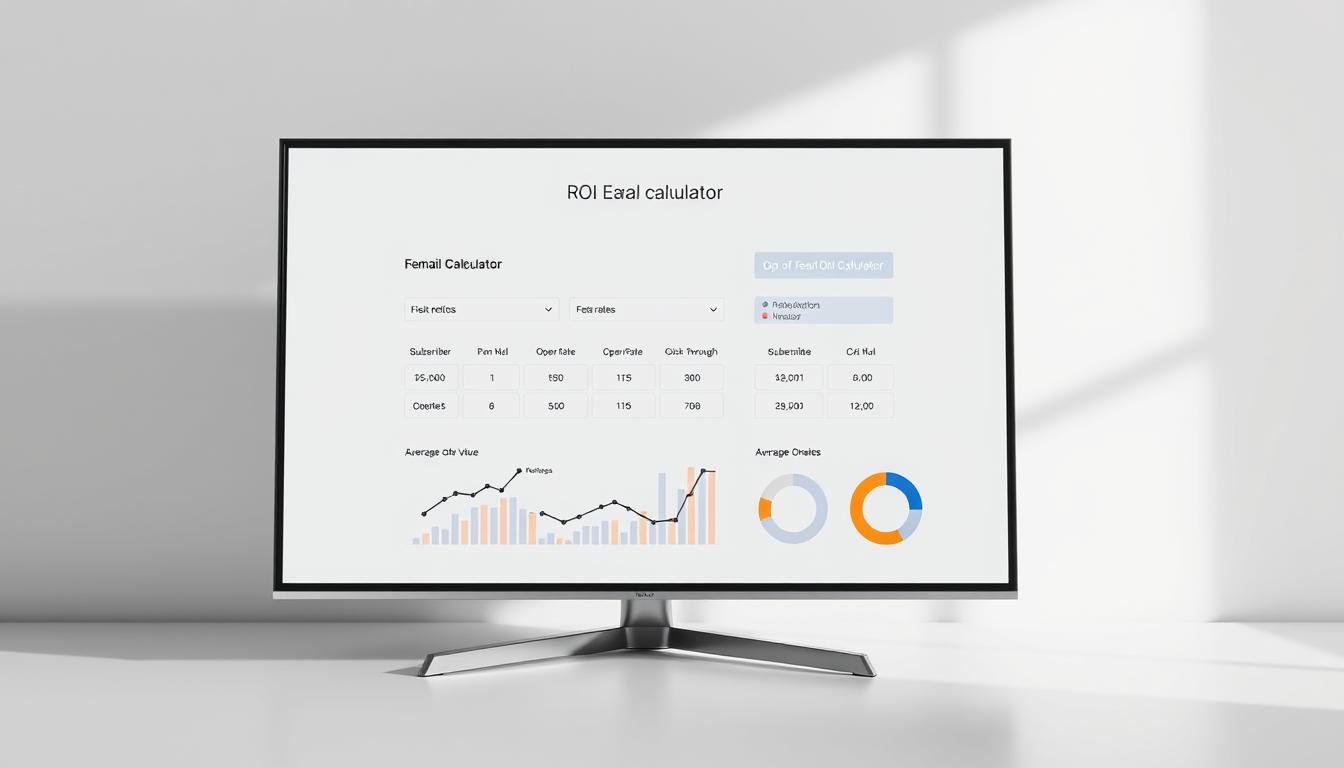Have you ever wondered if your efforts are truly paying off? You pour time and creativity into crafting messages for your audience, hoping to connect and drive action. But without clear numbers, it can feel like you’re navigating in the dark. Knowing the true financial impact of your work is the key to confidence and growth.
Our free tool is designed to eliminate that uncertainty. It provides instant, accurate results for 2025 and beyond. You simply input your data, and it does the rest. This powerful resource helps you see exactly how much revenue your campaigns generate compared to your investment.
For every dollar spent, this channel consistently delivers one of the highest returns in the digital space, with averages between $36 and $42. Understanding this performance helps you set realistic goals, justify budgets, and make smarter decisions for your business. It’s your starting point for maximizing the potential of every message you send.
Key Takeaways
- Measure the financial impact of your efforts with precision and ease.
- Gain clear insights into your performance by comparing revenue to investment.
- Set realistic goals and track your growth effectively for future campaigns.
- Eliminate guesswork with calculations based on your actual send volume and costs.
- Discover how this channel delivers an average return of $36 to $42 for every dollar spent.
- Justify your budget and make data-driven decisions on resource allocation.
- Use the tool as a foundation for optimizing your entire strategy.
Understanding Email Marketing ROI
To truly optimize your communication strategy, you must first comprehend what makes campaigns profitable. This understanding forms the foundation for smart business decisions and resource allocation.
Defining ROI in Email Marketing
Return on investment measures the profitability of your outreach efforts. It shows the relationship between what you spend and the revenue generated. The calculation is straightforward: subtract your total campaign investment from the revenue earned, then divide that profit by your original investment amount.
This metric provides critical insights for justifying budgets and evaluating strategy effectiveness. It helps you compare performance against other channels.
Key Metrics to Track and Benchmark Data
Tracking the right numbers gives you a comprehensive view of performance. Focus on open rates, click-through rates, conversion rates, and average order value. These metrics show how your efforts drive actual business growth.
Industry benchmarks reveal significant variations. Tech companies typically achieve 36:1 returns, while retail and ecommerce see 45:1 performance. Marketing agencies average 42:1. Understanding these standards helps you set realistic goals.
Small businesses often achieve 15% to 30% returns. Larger enterprises typically see around 10%. These differences highlight the importance of context-specific evaluation for accurate assessment.
Email Marketing ROI Calculator: Step-by-Step Guide
Ready to put your campaign data to work? This guide walks you through each step. Using the tool correctly gives you a clear picture of your financial performance.
Precise inputs lead to reliable results. This process connects directly to your overall strategy.

Input Parameters and Their Importance
Start by selecting your currency. This ensures all financial calculations match your accounting. USD, EUR, and GBP are common options.
Your contact list size is the total email send volume. For better accuracy, subtract about 1% for bounced messages. This gives a true count of delivered communications.
Determine your total cost per effort. Divide your monthly platform fee by the number of campaigns you send. This reveals the actual investment for each one.
Input the total sales generated directly from that specific outreach. Your platform’s tracking should provide this number. Advanced users can add open rate and conversion rate for deeper analysis.
Interlinking with Pillar and Cluster Content
The tool is not isolated. It works with core strategic content. This includes topics like list segmentation and budget planning.
It also links to tactical cluster content. For example, better deliverability affects your actual send volume. Improved list management boosts the quality of your audience.
Understanding your profit and break-even point helps plan future actions. This data supports testing methods and automation workflows. These strategies can increase the value you get from each subscriber.
Maximizing Your Email Campaign ROI
Transforming your outreach from good to exceptional requires strategic optimization techniques. Once you know your current performance numbers, the real work begins. You can systematically improve both engagement and financial returns.

Strategies to Increase Conversions and Engagement
Segment your contact list based on customer behavior and preferences. This targeted approach dramatically improves conversion rates. Personalized content resonates better with each subscriber group.
Use automation for triggered messages based on specific actions. These communications consistently outperform standard campaigns. They deliver higher open rates and better results.
| Strategy | Impact on Engagement | Effect on Conversions | Implementation Difficulty |
|---|---|---|---|
| List Segmentation | High | Significant | Medium |
| Automated Triggers | Very High | Substantial | Low |
| A/B Testing | Medium | Gradual | Low |
| Dynamic Content | High | Moderate | High |
Optimizing Costs and Investment Returns
Balance your platform pricing against the features you actually need. The cheapest option may not deliver the best value. Focus on tools that maximize your money-to-results ratio.
Use your marketing roi calculator to test different volume scenarios. See how changes in send frequency affect your bottom line. This planning helps optimize your investment without sacrificing quality.
Every communication should provide genuine value to customers. This builds loyalty and increases lifetime customer value. Strategic optimization creates sustainable growth for your business.
Conclusion
The journey from uncertainty to data-driven confidence begins with one simple step. You now possess both the knowledge and tools to accurately measure your campaign performance.
Start using the free tool today to analyze your current efforts. Identify improvement opportunities and plan future strategies with confidence backed by real numbers.
Exceptional roi requires ongoing optimization based on your specific industry benchmarks. Take action now by inputting your data, then explore resources about segmentation and automation.
Transform your approach to marketing with precise measurement. Your path to maximizing email marketing roi starts with this powerful foundation.
FAQ
What is a good return on investment for my campaigns?
A strong return varies by industry, but a good benchmark is typically between and for every
FAQ
What is a good return on investment for my campaigns?
A strong return varies by industry, but a good benchmark is typically between $36 and $40 for every $1 spent. Your actual profit depends on factors like your contact list size, conversion rates, and the total cost of your platform and content creation.
How do I calculate the total revenue from my sends?
To find your total revenue, multiply the number of conversions by the average value of each sale. For example, if 50 customers make a purchase with an average order value of $100, your revenue from that campaign is $5,000.
What costs should I include when figuring out my investment?
Your investment includes all expenses related to your campaigns. This covers your platform subscription fees, the cost of designing and writing content, and any fees associated with managing your subscriber list. Be sure to account for every dollar spent to get an accurate picture.
Can I use this calculator for a single campaign?
Absolutely. The tool is designed to evaluate the performance of both individual sends and your overall strategy. Inputting data from one specific campaign helps you understand its direct impact on your business and guides future planning.
How can I improve my returns if they are low?
Focus on strategies that boost engagement and conversions. This includes segmenting your contact list for more personalized messages, A/B testing subject lines, and optimizing your content for mobile devices. Reducing unnecessary expenses on your platform or design can also increase your net profit.
spent. Your actual profit depends on factors like your contact list size, conversion rates, and the total cost of your platform and content creation.
How do I calculate the total revenue from my sends?
To find your total revenue, multiply the number of conversions by the average value of each sale. For example, if 50 customers make a purchase with an average order value of 0, your revenue from that campaign is ,000.
What costs should I include when figuring out my investment?
Your investment includes all expenses related to your campaigns. This covers your platform subscription fees, the cost of designing and writing content, and any fees associated with managing your subscriber list. Be sure to account for every dollar spent to get an accurate picture.
Can I use this calculator for a single campaign?
Absolutely. The tool is designed to evaluate the performance of both individual sends and your overall strategy. Inputting data from one specific campaign helps you understand its direct impact on your business and guides future planning.
How can I improve my returns if they are low?
Focus on strategies that boost engagement and conversions. This includes segmenting your contact list for more personalized messages, A/B testing subject lines, and optimizing your content for mobile devices. Reducing unnecessary expenses on your platform or design can also increase your net profit.
